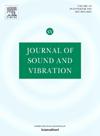Feynman–Kac-RBFNN for the stochastic analysis of Bouc–Wen hysteretic systems
IF 4.3
2区 工程技术
Q1 ACOUSTICS
引用次数: 0
Abstract
Hysteretic systems are fundamental in engineering, yet their stochastic response analysis remains a significant challenge due to the additional partial differential equations (PDEs) introduced by hysteresis. This paper investigates the application of a Feynman–Kac-based Radial Basis Function Neural Network (RBFNN) method for analyzing the stochastic response of Bouc–Wen hysteretic systems. By reformulating the Fokker–Planck (FPK) equation via the Feynman–Kac framework, the PDE is transformed into an integral form, eliminating high-order derivative computations typical in conventional RBFNN approaches. Additionally, short-time Gaussian approximation (STGA) is employed to derive analytical expressions for stochastic expectations. Building on existing RBFNN techniques, this study incorporates an inscribed spherical sampling strategy to efficiently solve for the trial solution weights. Numerical experiments on Bouc–Wen systems with both softening and hardening characteristics validate the method, showing strong agreement with Monte Carlo Simulations (MCS) in both marginal and joint probability density functions (PDFs). The results reveal bimodal distributions in the softening case, highlighting complex non-Gaussian stochastic dynamics. The framework reduces computational cost while maintaining considerable accuracy, offering a practical and efficient approach for nonlinear stochastic dynamics in engineering applications.
Bouc-Wen滞回系统随机分析的Feynman-Kac-RBFNN
迟滞系统是工程中的基础,但由于迟滞引入了额外的偏微分方程(PDEs),其随机响应分析仍然是一个重大挑战。本文研究了基于feynman - kac的径向基函数神经网络(RBFNN)方法在分析Bouc-Wen滞回系统随机响应中的应用。通过Feynman-Kac框架重新表述Fokker-Planck (FPK)方程,PDE被转换为积分形式,消除了传统RBFNN方法中典型的高阶导数计算。此外,采用短时高斯近似(STGA)导出随机期望的解析表达式。在现有RBFNN技术的基础上,本研究采用了一种内切球面采样策略来有效地求解试验解的权重。具有软化和硬化特性的Bouc-Wen系统的数值实验验证了该方法,在边际和联合概率密度函数(pdf)上与蒙特卡罗模拟(MCS)具有很强的一致性。结果显示软化情况下的双峰分布,突出了复杂的非高斯随机动力学。该框架降低了计算成本,同时保持了相当的精度,为工程应用中的非线性随机动力学提供了一种实用有效的方法。
本文章由计算机程序翻译,如有差异,请以英文原文为准。
求助全文
约1分钟内获得全文
求助全文
来源期刊

Journal of Sound and Vibration
工程技术-工程:机械
CiteScore
9.10
自引率
10.60%
发文量
551
审稿时长
69 days
期刊介绍:
The Journal of Sound and Vibration (JSV) is an independent journal devoted to the prompt publication of original papers, both theoretical and experimental, that provide new information on any aspect of sound or vibration. There is an emphasis on fundamental work that has potential for practical application.
JSV was founded and operates on the premise that the subject of sound and vibration requires a journal that publishes papers of a high technical standard across the various subdisciplines, thus facilitating awareness of techniques and discoveries in one area that may be applicable in others.
 求助内容:
求助内容: 应助结果提醒方式:
应助结果提醒方式:


